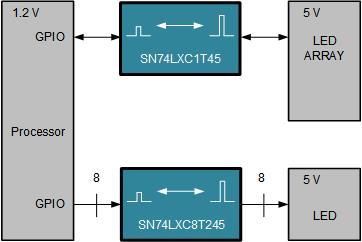SCEA115 August 2022 SN74LXC1T45 , SN74LXC1T45-Q1 , SN74LXC2T45 , SN74LXC2T45-Q1 , SN74LXC8T245 , SN74LXC8T245-Q1
1 Application Brief
Most people have experienced Wi-Fi® router issues. A critical part of trouble shooting Wi-Fi router issues is looking at the LED indicators that all Wi-Fi routers have to see what error is being reported or current device status. For many, flashing LEDs is a sign that something is working. As features and system complexities have increased, for electronic devices, the use of LEDs as status indicators has proliferated. Today, LEDs enable system designers to convey information such as system status, system warnings, power-up, and many other key system specific operation details. For system designers, using LEDs is the simplest and most cost-effective way to convey system information to users. LEDs have enabled system designers to develop products that are more user friendly and require less technical support.
System designers face design challenges when implementing status LEDs in their designs. The challenges occur because many newer FPGAs, processors, and microcontrollers in their systems are developed in smaller silicon process geometries. These geometries operate at lower core voltages, often < 1.8 V and have lower drive currents. The I/O of these newer lower-power processors and controllers often do not have the needed signal drive strength to drive LEDs, LCD modules, and multicolor LEDs that are used in new designs. Often, the I/O of modern processors have enough signal strength to drive short board trace or short cable runs between other circuits but not enough current to drive LEDs and small LCD displays.
To overcome the design challenges of driving LEDs with modern processors and controllers, designers are turning to higher current drive voltage translator devices to add needed current drive to their signals that drive LEDs and LCD modules. TI’s LXC family of direction-controlled level translators provides designers with voltage translators that have sufficient drive strength to drive LEDs. TI’s LXC voltage translation family is able to source up to 32 mA of output drive. The higher current source enables driving ICs that are connected through longer board traces. Additionally, the LXC devices can drive components requiring higher current such as LEDs and small LCDs which are common to the latest applications. With devices supporting different bit widths (1-bit SN74LXC1T45, 2-bit SN74LXC2T45, and 8-bit SN74LXC8T245), the LXC family has several different options for system designers for driving LED- and LCD-based designs (see Figure 1-1).
As signal chain components such as processors and micro-controllers continue their journey down the process curve, the current drive capability that these device I/O have will continue to diminish. Using simple logic level translation devices provides system designers a robust and cost-effective way to implement LED indicators in their systems without having to re-engineer their processor I/O.
For more information on TI’s LXC family of direction-controlled voltage translators, refer to TI’s translation landing page.
| Device | Description |
|---|---|
| SN74LXC1T45, SN74LXC1T45-Q1 | 1-bit, 1.1-V to 5.5-V translator |
| SN74LXC2T45, SN74LXC2T45-Q1 | 2-bit, 1.1-V to 5.5-V translator |
| SN74LXC8T245, SN74LXC8T245-Q1 | 8-bit, 1.1-V to 5.5-V translator |
 Figure 1-1 Processor Driving LED Example
Figure 1-1 Processor Driving LED Example